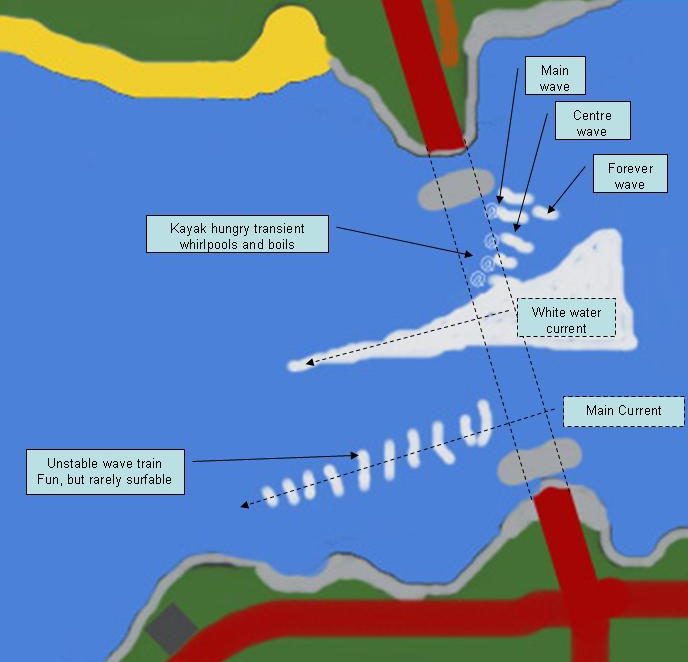Do they still work?
The short answer is “yes”. As you can see from the photo gallery there have been some fantastic sessions in the last couple of years.
Sometimes, from a playboater’s point of view, the falls can fall short of expectations. The main waves do not always form properly, which can be extremely frustrating. Various theories have been proposed as to why this happens. One theory is that cyclic kelp growth on the sea bed influences the flow. However, we live right beside the falls and have seen the waves working well one day and not working the next, so the kelp theory seems difficult to support. The main factors seem to be the tidal range on the day and the actual height of the tide at low water. The height of the tide often varies significantly from that predicted. We have observed tides up to 0.5 metres higher than the prediction at times of low atmospheric pressure and/or strong south westerly winds. On those days when big waves were expected but did not form well, the low water depth has been higher than predicted.
There is a lot more studying to be done yet, but at the moment my advice for playboaters would be – pick days when the predicted tidal range is over 3.5 metres and the low water prediction is 0.6 or less. If the weather is bad, i.e. low pressure and/or strong SW winds – think twice about coming or be prepared to paddle the Orchy instead. If in doubt, give me a call on 01631 710173
When it works, it really is awesome, in the original meaning of the word.
Information for playboaters
Location, access and parking information can be found here
Competent playboaters will probably only be interested in the ebb tide. The wave and current patterns change during the tidal range, the sequence is explained below:
These notes apply to ebb tides when the range is more than 3.2 metres
- During the first hour and a half of the ebb tide a small jet of water runs north of the north bridge pier. Good for a warm up. The real action doesn’t get going until this jet has virtually stopped.
- After two hours of ebb, the main wave starts to form by the north bridge pier and gets progressively bigger. If conditions are right, this wave becomes broken and provides a spectacular play-wave.
- On big tides, a second, narrow but very powerful stopper forms in the centre of the northern flow.
- About one and a half hours before low water, the Forever Wave usually forms up. This is a superb smooth green wave, about 30 metres out from the northern bridge pier. It can be hard to get on and is usually too slow for playboat moves but is an exhilarating ride none the less. When it is good, it is very stable with a slightly breaking crest. Ideal for surf boats and longer ww boats.
- Around low water, the main wave sometimes turns into a real stopper. It can be hard to get out of the resulting hole.
- The south channel will produces a narrow, very powerful, jet of water with unstable and angled broken waves. It is great fun to ride through it but it seldom provides surfing opportunities.
- At low tide the flow and waves gradually reduce. The flow reverses 2 hours 50 minutes after low water.

Beware
Make no mistake, the northern side of the flow on big tides is no place for anyone other than expert paddlers or intermediates with big lungs and strong nerves. The boundary line between the northern current and the eddy beside the northern bridge pier generates quite spectacularly sucky whirlpools with overlapping broken waves and boils around them. If you don’t get right out into the current and accidentally slide along the eddy line (eddy “zone” might be more accurate) you are in for an entertaining time.
Safety
Although lots of people have had long trashings followed by long swims, we are not aware of any serious incidents. (Please let me know if you have witnessed any yourself). Although extremely violent, the turbulence tends to spit buoyant objects back out after a few seconds. However, it can be a very long swim and the potential for being drawn down by a whirlpool is real. So please consider the following recommendations.
- Full air bags, high spec P.F.D., etc are essential.
- Wear a helmet. You are unlikely to hit the bottom with your head but you could easily get donked by your own paddle in the extremely violent eddy zone.
- There should always be at least one group member acting as a spotter at any time. This is to avoid the possibility of someone getting into serious trouble without anyone else noticing.
- If you are one of those people who paddle it solo, please think deeply about the risk you are taking. If you choose to persist with this, have a friend watch you or at least call me or knock on my door before you go on and let me know when you have finished. Surely this is sensible Telephone 01631 710173 I might even come out to keep you company if I have time.
Enjoy!
Tony Hammock
Seafreedom Kayak